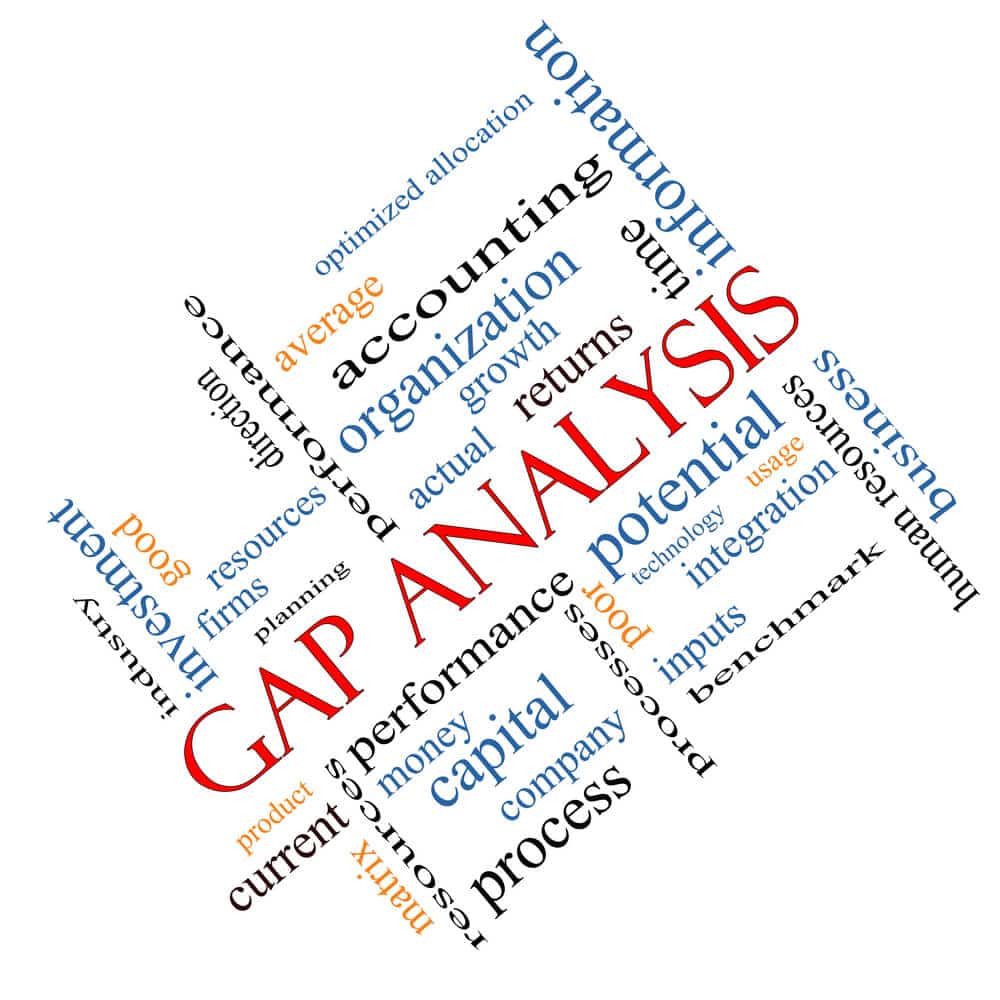GAP analysis can be used alongside marketing cost analysis. But it’s transferable to management, customer experience, employee training and more.
GAP analysis can be used alongside marketing cost analysis. But it’s transferable to management, customer experience, employee training, and more.
Here we’ll discuss what GAP analysis is and why it’s necessary for making positive changes in your business.
What is GAP Analysis? Here are your GAP analysis goals
A GAP analysis helps to bridge the gap between the current state and the future state of your business. The future state (results) should show a positive change.
In GAP analysis, the goal is to identify current behavior and acknowledge what new behavior you want to see. Basically, what is your current state, and what results do you want to see in a specified timeframe?
In essence, this analysis will help “close the gap” between one state into another. The change doesn’t need to be overly detailed. But it should move your business down a path of success.
A GAP analysis example
For instance, maybe you’re looking to grow your Twitter account. You’re currently at 500 followers and want to increase it to 1500.
The ‘500 followers’ is your current state. ‘1500’ followers is where you want to go. And now you need to cement why you want this change.
Do you simply want a boost in followers, which will make you appear as an authority in your industry? Or do you want increased authentic engagement, which means building a following will lead to that?
In the end, what is the goal for these 1500 followers?
Perhaps you’re looking to convert them into customers. Maybe you intend to have them contribute to your user-generated content strategy. Either way, you’re looking to implement this change in your GAP analysis for a reason.
Understanding your why is the first step to seeing it happen.
How to use GAP analysis for success
The first step is to identify the current behavior you want to change and the future behavior (or result) of the change. But that’s only the start because a goal is just words if a plan isn’t involved.
Back to growing your Twitter following example. Several methods can lead to increasing the number from 500 to 1500. Such things include:
- Tweeting regularly
- Identifying your target market
- Researching hashtags your target market use
- Following and interacting with influencers in your industry
- Creating a Twitter marketing plan for promotions/engagement
- Bringing attention to your Twitter account on your business website
All of these methods work together to help increase engagement and interaction on Twitter. Tweeting regularly is easy, but what to tweet — that your target market will enjoy — takes more research. As does creating a business campaign or conversion strategy to move these followers into customers.
So, alongside knowing your current situation (500 followers) and where you want to go (1500 followers), you need a plan to get to that point.
When you use GAP analysis, it’s important to have enough information about how you’re going to “close” the gap between the current situation and the results you’re after. Too much information can lead to confusion. But too little information may make it difficult to bring the goal to fruition.
Remember, GAP analysis is not just related to marketing. It can be used in leadership programs to increase customer experience, helping to increase the morale of current and prospective employees, and much more.
In any department you’d like to increase or change current behaviors, GAP analysis applies.

How to Write a Proper GAP Analysis Template
Here is what every successful GAP analysis template should have. It’s nothing too complex, and it’ll help your firm go from Point A to Point B (positive change) easier.
Step 1: Detail your current situation and what you want it to become
You have a situation. It’s an aspect of your business that could massively benefit from a change. For example, how about boosting the morale of current sales employees because they’re becoming lethargic and sales are suffering? Or how about reducing the shipping costs of online orders?
The great thing about GAP analysis is that it applies to any department. Deciding which one to start with is the difficult part.
It’s important to note exactly what the current situation is but also what result you want to have. So, say you want to sell a specific number of eBooks products per month. And you’ll increase your profits by X%. You’ll first need to know how many products you’re currently selling. With this information, you’ll see how much work needs to be done to see your result.
So it would look like this:
Current: Your number of sales per week is 50 (at $19.95 each). The number of sales per month is 200 ($3,990). Profits, after taxes (~25%), are $2,992.50.
Result wanted: The number of sales increased to 70 per week (at $19.95). The number of sales per month increased to 280 ($5,586). Profits after taxes (~25%) will be $4,189.50. This will be achieved after six months.
This would be a 40% increase in profits.
For a goal like this, you’ll have (and need) hard numbers. Your current sales and profits should be available through financial records. And your current marketing methods will also be recorded.
Some of these methods could include:
- World of mouth/referrals
- Offline marketing (brochures, direct mail, billboards)
- Social media marketing
- Email marketing
- Influencer/Blogger outreach
- Organic traffic via SEO
This brings us to step two:
Step 2: Create a plan to see the result
You know what current methods contribute to your current situation. Now you have to find a way to either expand upon those resources or create an entirely new plan to see the results.
This could require retouching upon target markets by consulting or creating buyer personas. You could also complete competitor analysis to see how your competition is targeting prospective customers.
In order to see a 40% increase in profits, as our example suggests, you could use the data collected by competitor analysis. But you could also examine your:
- Sales page
- Promotional strategies
- Product packaging
- Shipping & handling fees
- Marketing outreach
It’s best to be detailed about the strategies you’ll use to take your current state into the future state (the increase in sales). It would look something like this:
Next steps: These are the immediate changes examined to increase product sales by 40% in a span of 6 months.
- Rewrite the sales page for stronger conversions
- Use targeted Facebook Ads for seven days (promotion period)
- Create a contest on Facebook and Instagram (promotion and conversion)
At this stage, doing a cost analysis is important here. It’s best to know how much these “next steps” will cost the company. Will it be profitable? Do you have the funds to allocate to these methods? If not, then it may not be worth the trouble financially.
But for your GAP analysis template, this is really all there is to it. You write down where you’re currently at, where you want to be, and how you want to get there. GAP analysis, in this form, is a good start. It’s best complemented by:
Next, we’ll dive more into the GAP analysis by explaining the truth behind Skills GAP analysis and Fit GAP analysis, how both may benefit your business when used actively, and how it applies to your future goals!

Everything You Need to Know About Skills GAP Analysis
Skills GAP analysis is related to GAP analysis. It shares the same common factor of “closing the gap” between A and B. In the case of skills GAP analysis:
- “A” equals a job or task to be completed, and
- “B” equals the skills necessary to complete that task.
A simple way to understand the analysis
The easiest way to think about skills GAP analysis is when hiring a new employee or subcontractor.
You’re hiring someone to fulfill a specific role in your company (the job/task). The person you hire will have the appropriate skills to handle the task (skills necessary). If the company objectives switch or the person’s skills aren’t enough, then the job ends, or the employee is fired.
What you need to have in order to conduct a complete skills GAP analysis is…
- A defined business goal or plan and,
- A list of the skills needed for successful results
How to start your skills GAP analysis
Specifically, it’s best to design a plan with business goals, objectives, expenses, and the ideal person to carry it out. This person may need to be hired, but they also might already be a part of your team — you just need to weed out which person is best to complete the goal.
While you could list off the required skills, it’s best to get them from data. If the business goal is related to sales or marketing, your competitors may have followed a similar campaign. With the right tools, you can research their results and identify which skills brought them to their goal.
Or, if this new goal is similar to an old one, look at which team members worked towards that goal. Their skills will be closely linked to what you need.
Another thing you can do is collect data through surveys. If your goal is related to customer experience, having existing customers answer your questions may help round out the bigger picture.
Keep all this information in a spreadsheet. The columns will be broken down into objectives, goals, results of goals, and skills necessary.
What next?
With the data collected, it’s time to translate it. This means identifying the skills the job needs.
So, your goal may require a dedicated team manager, or perhaps you’re dealing with a new technology that will require the company to explain complex concepts in simplistic terms.
Because you collected data from various sources, you know what gaps you’re lacking. And by proxy, you understand which skills you’re looking for. Now it’s clearer which direction to use to complete your company goal.
You may need to hire new people, but you may also be able to provide training for existing team members.
While training can be expensive in the short term, if similar projects arise in the following months, your team will have the necessary skills to complete them. This will save money from having to hire new people each time.
The bottom line is that skills GAP analysis will help you identify skills required for a goal to be met and make a plan to decide how to get these skills in the most defined method.

A Critical Role Fit GAP Analysis Plays in Business Success
We’ve looked at the process behind GAP analysis, including templates. This time, we’re looking into how fit GAP analysis helps identify existing problems in business, specifically in systems and processes.
If a system isn’t working in your firm, how do you go about fixing it? This is exactly where fit GAP analysis works.
Let’s say employees are supposed to recommend an exclusive promotion when customers buy a product from you. And yet, the numbers show almost no one has actually signed up for the service. This means this ‘process’ isn’t the best fit.
Several problems could be happening at once:
- Employees aren’t telling customers about the sale
- Customers are having difficulties signing up
- The way employees explain the sale is confusing
- Customers aren’t interested because lack of benefits
In actuality, it could be more issues than this. But you should note the many things which could be interfering with achieving the goal. Over time, and through data analysis, you’ll be able to narrow it down.
How to start a fit GAP analysis
There are three steps to starting your fit GAP analysis.
Step 1. First, you need to look at your expected results. Are you looking for a number of signups per month? Is there a certain profit margin you wish to hit because of this sales promotion? Are you just trying to garner interest in the sale? Write your goal thoroughly.
Step 2. Write down the current results you’re getting. This is the problem area but also where your current system is putting you. It’s not where you want to stay, but knowing where you’re starting from helps to move the process forward.
Step 3. Examine the possible problems (the bulleted list above) and examine what needs to change to resolve the problem. This is where noting all possible communication and technical difficulties come into play.
With these steps, you’ll be able to conduct a thorough fit GAP analysis to determine which processes are a better fit for your company goals.
The goal of fit GAP Analysis
What fit GAP analysis helps you do is acknowledge problems, see the gap between current and expected results, and adjust your process until you get what you want.
Then it’s about improving the problems through actionable steps, setting goals to see the effect, and maintaining the results with this new system change.
So what do you get out of a fit GAP analysis?
A system to help address current flaws in your business goals.
Anytime something feels off (or the data shows you a process isn’t working), fit GAP analysis helps you start looking for a better fit.
You’ll be able to:
- Acknowledge current issues (lack of results)
- The processes used that are providing these lackluster results
- How to close the gap between those two points and
- What results you want to see
To get an even better understanding, combine fit GAP analysis with the other types of GAP analysis for an overall better understanding of your current systems and skills.


